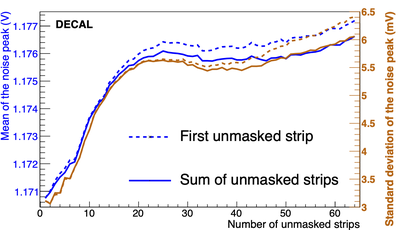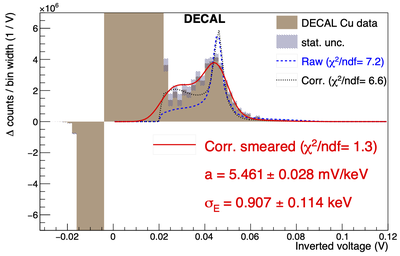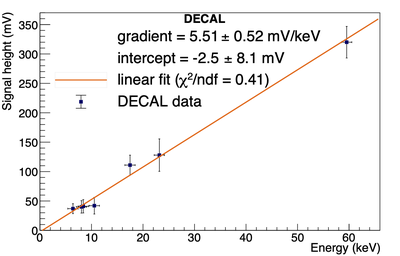Previous Studies by Master/Bachelor students at HU
The following studies are examples from previous bachelor and master theses.
Tuning the sensor / Noise study

One of the first studies done by a master's student was tuning the sensor: Every real-life device has imperfections. For silicon detectors, these small imperfections can lead to different sensitivity of the various pixels to the same signal. To overcome those, a tuning circuitry is implemented in every pixel that allows slight modification of the pixel response to the signal with the goal of turning all pixels to have the same response for equal signals.
One thing the student was able to show is that the response of the signal depends on the occupancy of the sensor (in the figure given by the number of unmasked (i.e. active) strips of pixels) and that the noise increases with occupancy.
Bias voltage studies

A bachelor's student did her thesis on characterizing the behaviour of the sensor depending on the bias voltage.
Usually, the efficiency of a silicon sensor flattens out at high bias voltages as the sensor is fully depleted.
The student was able to show that the bias-voltage dependence of the DECAL sensor does not flatten (the fitted lines are not constants). The origin of this feature still needs to be studied further.
The sharp turn-on of the bias-voltage curve in the picture here is not the true sensor behaviour (the turn-on is wider), but was due to a faulty element on the motherboard and has been fixed by now.
Energy calibration
While the DECAL sensor is designed to measure “hit” information and not energy, the conversion between the threshold of recording a hit and the deposited energy of a particle needs to be known in order to be able to extract the particle energy from the number of hits in a particle shower. Thus, a master student calibrated the DECAL sensor using radioactive sources and X-rays.
The picture on the left shows in brown the number of hits reconstructed by the DECAL sensor as a function of the threshold voltage to reconstruct a “hit” under fluorescence light from a copper X-ray target. A reference spectrum (HEXITEC) is also shown (blue line) and corrected for measurement effects in silicon (red line). Using the known energy measured with the reference spectrum one can extract the energy measured by DECAL as a function of the signal height of the threshold voltage. That extracted dependency for the copper X-ray measurement together with other measurements is shown on the right. A linear correlation between the signal height and the converted energy is found.
Potential future thesis topics
You will find a list of potential projects under this Link (that contains also thesis projects within ATLAS or for quantum sensors). This list can be extended and further projects can be developed depending on the student’s skills and interests. If you are interested in working with us, please contact Dr. Hannsjörg Weber (weberhaa@hu-berlin.de), Prof. Cigdem Issever (isseverc@hu-berlin.de), or Prof. Steven Worm (steven.worm@hu-berlin.de).


